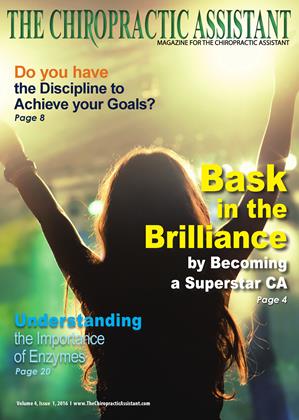ANATOMY IN ACTION SERIES: Tennis and Golf Elbow
Educational articles designed to help CAs understand the underlying anatomy and physiology of conditions presenting to the chiropractic office.
Laurie Mueller
Extremity pain is no stranger to the chiropractic office; shoulders, elbows, wrists, knees, and feet are very commonly seen by DCs. This article will focus on the conditions called “tennis elbow" and “golf elbow." The more formal terms for these conditions are “lateral epicondylitis" and “medial epicondylitis," respectively.
Anatomy of the Elbow
The elbow is the synovial hinge joint between the humerus in the upper arm and the radius and ulna in the forearm that allows the hand to be moved toward and away from the body. These bones are joined by cartilage, tendon, and ligament. The annular ligament, which surroundsthe head of the radius bone where it joins with the humerus, is of special note. Also, note that though the superior radioulnar joint shares a joint capsule with the elbow joint, it plays no real functional role at the elbow. The elbow region includes prominent landmarks such as the olecranon (the bony prominence at the very tip of the elbow), the elbow pit, and the lateral and medial epicondyles.
Important Considerations
These conditions are named after sports, but patients don't have to be avid athletes to get them. In fact, they are often more common for nonathletes! Weekend warriors are prone to a sprain/strain of one of the joints. Also, don't forget that anyone who engages in repetitive motion that uses the joints in question could also get the conditions—for example, factory workers or construction workers.
If you are standing in the anatomical position (standing with arms to the sides and palms facing forward), then tennis elbow can be found on the lateral (outside) of the elbow region. Golf elbow can be found medially.
Patients do not typically present with both conditions at once. Lateral epicondylitis stems from the overuse of the wrist extensor muscles, i.e., the mus-
des on the back of the arm (in anatomical position) that attach to the lateral side of the elbow region. Medical epicondylitis is the opposite—overuse of the wrist flexor muscles, i.e., the forearm muscles located on the anterior (front) of the arm that attach medially.
Management of Lateral and Medial Epicondylitis
To resolve the problem, the affected joint may need to be adjusted to move the joint back into a normal position. The patient may wear a brace to limit motion while the damaged soft tissues regain stability and strength. Hot/cold therapy or EMS may also be indicated to usher blood in and out of the tissues and promote healing. Of course, lifestyle changes must also be addressed so that the patient is not engaging in the activities that caused the problem while it's trying to heal.
In addition, if caused at work, ergonomic issues, such as technique, work positioning, or wearing a brace, may need to be addressed before the patient resumes the activity.
Education Fosters Understanding
An understanding of anatomy and clinical applicability helps all health-office employees better communi-
“of course, lifestyle changes must also be addressed so that the patient is not engaging in the activities that caused the problem while it's trying to heal.”
cate with patients and provide care more safely. Online training programs in particular make high-quality training affordable and convenient and can be taken any time of day. At www.CCCAonline.com, learners can engage in a streamlined 24-hour training program that meets or exceeds FCLB guidelines in every area of study and fulfills the training requirements needed for the national examination!
DCs will often pay for their employees to train. Full price for this training is an affordable $339 for the entire 24-hour program, and www.CCCAonline. com has a special discount available for you! If you are receiving this article through The American Chiropractor magazine, use AMCHIRO as your discount code. When you enter this code during the registration process, it will automatically provide a $15 discount off the regular price of the program. This is the program that gives back to the profession.
Learners can expect text, images/schematics, dynamic video lectures, and robust, customized, experiential interactivities in a thorough 19-module program. Plus, an extensive note-packet of nearly 200 pages is included that can be downloaded, printed, and studied off-line. Learners work at their own pace and can conveniently take programming around work hours to avoid disruption in the office. Questions? Visit our website or send us an e-mail at [email protected].
■ Laurie Mueller, BA, DC, CFMP served in private practice in San Diego, California. She was the postgraduate director at Palmer College from 2000 to 2010; served as the ACC postgraduate subcommittee chair for six years; peer-reviewed for the Research Agenda Conference; and wrote the informal role determination study that aided in the development of FCLB ’s guidelines for chiropractic assistants. Dr. Mueller currently works as a private eLearning consultant with a focus on healthcare topics and functional medicine through her company, Impact Writing Solutions, and the subsidiary, CCCAonline.com. She is a clinician, an educator, and an expert in online educational pedagogy.
 View Full Issue
View Full Issue






